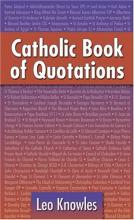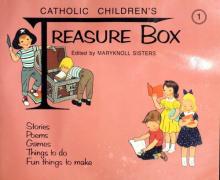No name
Catholic Book of Quotations
This inexpensive paperback offers a wide variety of memorable Catholic quotations from both ancient and modern sources. The book is organized according to subject. Here are just a few: Abortion, Art, Baptism, Blessed Sacrament, Conscience, Devil, Divine Mercy, Dying Words, Family, Fasting, Free Will, Generosity, Grace, Guardian Angel, Incarnation, Justice, Marriage, Our Lady, Prayer, Priesthood, Rosary, Sin, Suffering, Transubstantiation, Virtue and Vocation. Authors quoted in this work include: St. Augustine, Pope John Paul II, Msgr. Robert Hugh Benson, St. Josemaria Escriva, St. Thomas Aquinas, St. John of the Cross, G. K. Chesterton, Charles Péguy, St. Ignatius Loyola and St. Padre Pio. There are a few authors that might raise a few eyebrows, but I didn't find anything off-base. I've really enjoyed having this around the house to find some inspiration, highlight an idea when writing to someone or complete a special project (I just made a plaque for my daughter's room with a quote from St. Francis that I found in this book).
Catholic Bookmark Kit from Illuminated Ink
Catholic Cardlinks: Bible
Catholic Cardlinks: Patron Saints
Children will love (I speak from experience with my own brood) to befriend the saints with this charming resource that they can so easily hold in their little hands. Each elongated cardstock sheet has a colorful sketch of a saint (48 saints in all) with a short biography. The pages fan out so that you can see all of the faces at once. Or open to one at a time and spend a little time reading about your favorites. When I leave this sort of book laying in reach of my little ones (especially the pre-readers), they will become acquainted with the pictures over time and find their favorites that they ask me to read about over and over. What a nice way to help young children develop a devotion to a favorite saint!
I'm also delighted to see such colorful and creative resources being published for young children.
Binding details: cardstock pages pivot on a sturdy post
Catholic Catechism on the Angels
In today's culture, angels are represented on everything from popular television programs to needlecraft projects, but they are rarely portrayed accurately. This little powerhouse of a book sets the record straight on Catholic teaching regarding our "holy helpers". Thorough but concise, it is written for upper high-school students and adults.
The book is organized into three sections that take the form of a brief essay followed by a question-and-answer catechism clarifying each point made. Father Hardon begins with a study of the angels, providing an explanation of angelic terms and definitions commonly used in reference to angels; adversaries, which are those individuals or systems which deny the doctrines about angels; and doctrinal value, which refers to the need for a believing Catholic to accept what is taught by the Church. He continues with the Catholic doctrines on the existence of angels from three different directions: ecclesiastical authority, sacred scripture, and theological reasoning. Finally, Father Hardon concludes with the proofs that angels are pure spirits from ecclesiastical authority, sacred scripture and tradition, and patristic evidence.
Imprimatur and Nihil Obstat
Catholic Children's Treasure Box
This set of colorful books for ages 3-8 are reprints of a Catholic magazine from the 1950s. They are filled with stories, games, picture puzzles, poems, crafts, etc. The pictures are beautiful and I like the very simple moral lessons many of the stories teach. (For example, when my daughter was three, she was very impressed by a story called "Peter the Picky Eater". Her eating habits changed and she honestly admitted that she wished I hadn't read it to her.) There are currently 20 volumes in print out of more than 60 that were originally published (unfortunately it may take quite awhile to find out what happens to Wupsy in the end!).
We have especially enjoyed the St. Therese stories from the first few volumes. These have been a favorite mostly among the preschool set in our family. While many Catholic homeschool parents treasure these books, there are two complaints that I've heard from a number of parents. First, some parents have bought the set thinking they would be nice for early grade school and found them to be more appropriate for preschool (as read-alouds). Second, the pedagogy at times doesn't hold up to serious scrutiny. Complaints include the sappy way in which the devil is presented in the Wupsy stories and the "self-righteous" expressions on some of the faces in the illustrations.
Catholic Children's Treasure Box Books 1-6, story of St. Therese
Catholic Children's Treasure Box, Volumes 7 and 8
These two volumes of the Treasure Box Books contain a very simple story of Mary's life, appropriate for very young children. The full-color illustrations are quite charming. Please note that this story has the marriage of Mary and Joseph come before the Annunciation, which is not in accordance with the actual Bible account. Perhaps the authors felt that very young children weren't ready to understand this part of the story.
Update from webmaster, March 2024: Bible scholars tell us that what is often translated as "betrothal" was really the first part of a two-part Jewish wedding rather than an engagement; in the time of Christ, these two parts were celebrated on separate dates separated by as much as a year. However, the couple was legally married after this first ceremony although they would not live together until after the second. This is why Matthew 1:18-19 reports that when St. Joseph discovers that Mary (his "betrothed") is with child, "her husband Joseph" resolves to divorce her (or send her away) quietly — husband and divorce, because they are legally married. See this article for more details and some profound implications for familiar Gospel passages: No, Mary Was Not an "Unwed Mother." Thus, the Treasure Box account is (perhaps unintentionally!) rather accurate on this point.
Catholic Education: Homeward Bound
I know a number of people who decided to homeschool based on the information provided in this book. The authors have done a very impressive job of outlining the positive benefits of homeschooling, in a non-threatening fashion. Because many of the reasons they give for homeschooling focus on practical and "natural law" reasoning they can be easier for some people to handle than arguments that focus on Church teaching (after all, you have to start somewhere =). The authors cover the benefits of having your children at home with you, concerns about the academic aspects of homeschooling, socialization, the role of the father, and spiritual advice for busy mothers. I was especially impressed with the nearly forty pages devoted to homeschooling highschoolers. Unlike other books which seem to treat all teens as rebels (which I have found disappointing as a former homeschooled-teen), Mrs. Hahn and Mrs. Hasson discuss ideas for making the most of the high school years through homeschooling. Also included in the teen section is a lot of information about homeschoolers preparing for and getting accepted into college.
Remember that you shouldn't treat any of the Catholic homeschool books as a perfect and complete guide. (This is why I recommend reading a number of them for the sake of balance.) This book has a bias toward putting together your own program and doesn't portray the benefits of using a structured program particularly well.
The resources section in this book is extensive, but is certainly not its strong point. Several of the resources used by the two authors are considered problematic by some Catholic homeschoolers. In terms of the lifespan of the Catholic Homeschool movement, this book is already quite old (published in 1996). We should be grateful that there are many more excellent choices, in terms of programs, books and other materials, for Catholic homeschoolers today than just a few years ago.









